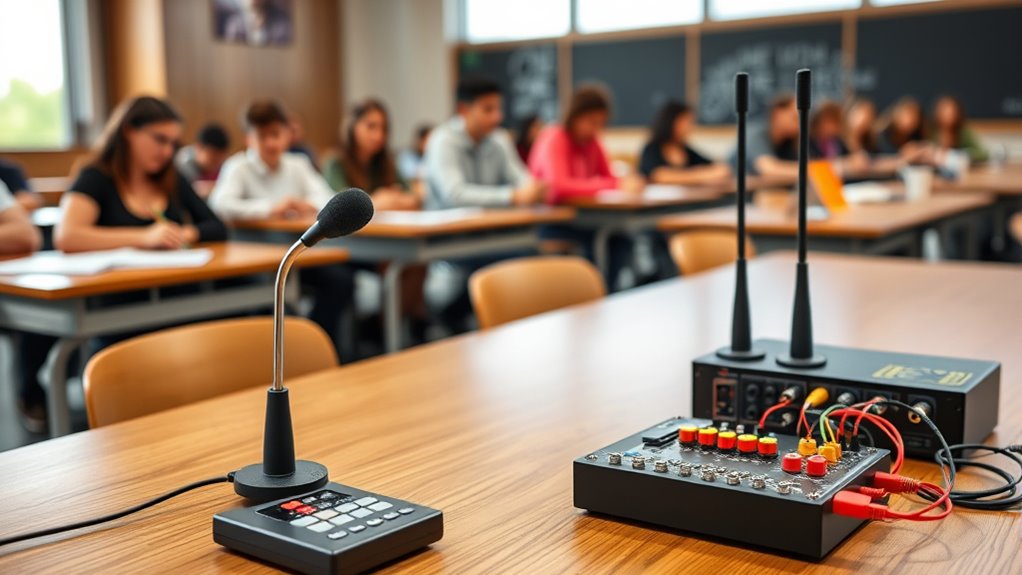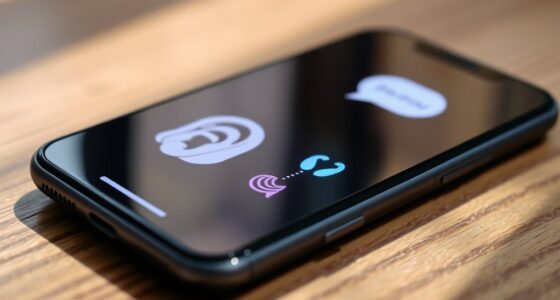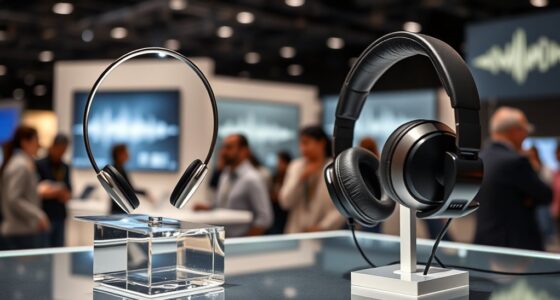Remote microphones and classroom kits help you create clearer, more engaging lessons by eliminating cables and allowing free movement for both teachers and students. They guarantee consistent sound coverage even in large or acoustically challenging spaces, making lessons more inclusive and understandable for all learners. With features like noise reduction and easy setup, these systems enhance safety and simplify your teaching environment. Keep exploring to discover how these solutions can transform your classroom experience.
Key Takeaways
- Wireless classroom kits enable clear, consistent audio without wires, enhancing engagement and interaction.
- Easy to install and set up, reducing classroom disruption and safety hazards like tripping over cords.
- Advanced features such as multiple channels, noise reduction, and digital processing improve sound quality and coverage.
- Support inclusive education by providing reliable audio for students with hearing impairments and diverse learning needs.
- Seamlessly integrate with multimedia tools like projectors and smartboards to create dynamic teaching environments.

Remote microphones and classroom kits have become indispensable tools for enhancing communication and learning in modern educational environments. These devices leverage wireless technology to deliver clear, consistent audio throughout the classroom, making it easier for both teachers and students to engage effectively. When you choose a wireless microphone system, you’re investing in an amplification system that eliminates the clutter and limitations of wired setups. This freedom of movement allows educators to move around freely, interact dynamically with students, and maintain eye contact—all without being tethered to a fixed spot. As a result, lessons become more engaging and inclusive, accommodating various teaching styles and classroom layouts.
Using wireless technology in classroom kits also simplifies installation and reduces the risk of tripping hazards caused by cords. You can set up the system quickly, with minimal disruption to your daily routine. The amplification systems integrated into these kits are designed to project sound evenly and clearly across the entire room, ensuring every student can hear the teacher’s instructions, questions, and discussions. This is especially beneficial in larger classrooms or spaces with acoustical challenges, where traditional audio methods might fall short. The high-quality sound amplification improves comprehension and minimizes misunderstandings, fostering a more effective learning environment.
Wireless classroom kits simplify setup, reduce tripping hazards, and ensure clear sound coverage for effective learning environments.
Furthermore, many modern classroom kits come equipped with features like multiple microphone channels, adjustable volume controls, and digital signal processing. These features give you greater control over audio quality, helping you tailor the sound output to match your specific needs. Wireless microphones often include noise reduction technology, which filters out background noise and ensures your voice remains the focus. This enhancement is essential in busy or noisy settings, where clarity can otherwise suffer. Additionally, some systems offer integration with other classroom technology, such as multimedia projectors or smartboards, creating a seamless digital learning experience. Incorporating innovative audio solutions can further enhance the effectiveness of your teaching tools.
Choosing the right wireless amplification system for your classroom can also support inclusive education. For students with hearing impairments or those who learn better through auditory input, a reliable microphone setup guarantees they don’t miss critical information. It helps create an environment where every learner has equal access to instruction, fostering a more equitable classroom atmosphere. Overall, the combination of wireless technology and advanced amplification systems transforms the way you teach, making your lessons more interactive, accessible, and effective. As technology continues to evolve, so does the potential for creating dynamic, engaging learning spaces that meet the needs of all students.
Frequently Asked Questions
How Do I Troubleshoot Audio Issues With Remote Microphones?
To troubleshoot audio issues with remote microphones, start by checking for audio interference from electronic devices nearby. Make certain your microphone placement is ideal—avoid placing it too close to metal objects or sources of interference. Test the microphone connection, replace batteries if wireless, and verify settings on the receiver and transmitter. If issues persist, try resetting the system or updating firmware to enhance performance and eliminate potential glitches.
Are Remote Microphones Compatible With All Classroom Audio Systems?
Don’t put all your eggs in one basket; remote microphones aren’t compatible with all classroom audio systems. You need to check the wireless connectivity options and confirm your system supports the microphone’s frequency and interface. Compatibility varies, so verify with the manufacturer’s specifications. This guarantees good audio quality and seamless integration, preventing frustration and ensuring your lessons run smoothly. Always double-check before investing to avoid unnecessary headaches later.
What Is the Typical Battery Life of Wireless Classroom Microphones?
Wireless classroom microphones typically offer a battery life of 6 to 12 hours, depending on the model and usage. You can prolong this time through effective power management, like turning off microphones when not in use or choosing devices with rechargeable batteries. Regularly monitoring battery levels helps guarantee your microphones stay powered throughout lessons, preventing interruptions and maintaining clear communication in your classroom.
Can Remote Microphones Be Used Outdoors?
Think of remote microphones as your trusty sidekick, ready for outdoor sound amplification. Yes, you can use weather resistant microphones outdoors, but keep in mind that environmental factors like rain or dust may affect their performance. Choose models specifically designed for outdoor use to guarantee durability and clear sound. Always check the microphone’s specifications to prevent it from becoming a vintage relic faster than your favorite cassette tape.
How Secure Are Wireless Microphone Signals From Interference?
Wireless microphone signals are generally safe but can face interference from radio frequency congestion. You should look for models with signal encryption to protect your audio from eavesdropping. To minimize disruptions, choose microphones operating on less crowded frequencies and use systems with interference rejection features. Regularly check for updates and maintain your equipment to ensure a strong, secure connection, especially in environments with many wireless devices.
Conclusion
With remote microphones and classroom kits, your teaching becomes as clear as a bell ringing in a quiet room. These tools help you connect with every student, no matter where they sit. You’ll find it easier to keep everyone engaged and assure your lessons are understood. Think of it like turning up the volume on your voice, making sure your message reaches every corner of the room. Embrace these tech tools and watch your teaching thrive.











